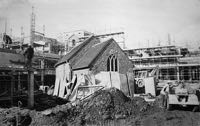
St Pancras' Church
Page updated 15th March 2019
 A small church situated in the Guildhall Centre,
and in what was once known as the British Quarter of the city, it is a
haven of calm amidst the commerce. Dedicated to St Pancras, the teenage
martyr, the church is one of the oldest Christian sites in England with
a chancel and nave.
Only 46½ ft by 16 ft, and built of Heavitree stone, it was first
recorded in 1191, although the font is all that remains from that
period.
The majority of the surviving church dates from the 13th century, with
some 16th century windows and a waggon roof. There was a small
graveyard associated with the church.
A small church situated in the Guildhall Centre,
and in what was once known as the British Quarter of the city, it is a
haven of calm amidst the commerce. Dedicated to St Pancras, the teenage
martyr, the church is one of the oldest Christian sites in England with
a chancel and nave.
Only 46½ ft by 16 ft, and built of Heavitree stone, it was first
recorded in 1191, although the font is all that remains from that
period.
The majority of the surviving church dates from the 13th century, with
some 16th century windows and a waggon roof. There was a small
graveyard associated with the church.
The church fell into disuse in the early nineteenth-century before being restored in 1831 by Robert Cornish, who repewed the seating; he was also responsible for one of the two large warehouses on the Quay. The remains of a Saxon doorway was discovered during the restoration along with carved fragments high in the south wall of the chancel.
The bell turret contains a small bell founded in Mermaid Yard, off Coombe Street by Robert Newton, who established his bell foundry in 1423. The bell is inscribed Quamvis sum parva tamen audior ampla per arva or "I may be small, nevertheless I am heard over a wide distance".
Another Restoration
The church had a second restoration, at a cost of £670, in 1888 by Pearson, architect of Truro Cathedral. The chancel arch was rebuilt at this time. It had seating for 100 provided, in what is a very small space. To help support it, the church had glebe land of 13 acres, although there is no indication of its locality.
When Allhallows in Goldsmith Street was demolished in 1906, some furnishing was transferred to St Pancras including a Jacobean pulpit and some tablet memorials that are dedicated to victims of smallpox. The south east corner was chamfered to allow the easier passage of carriages and carts in earlier times.
In July 1868, the editor of the Western Times, Thomas Latimer, brought an action against the rector of St Pancras to recover the sum of £2 7s 6d for advertising in his paper. The rector's defence was that he was 'mentally afflicted' and therefore not responsible for his actions. The judge pronounced that the defence was insufficient and gave the verdict to Latimer.
The Victorian church goer was often treated to a sermon related to events and in 1863, the death of Prince Albert was no exception, when the Rev. John Cole gave a sermon on 'The Shortness and Uncertainty of Life' at the church. A subject that was applicable to many in the poorer quarters of the city.
During the First War, the Bishop considered closing St Pancras, among others, to free up chaplains for the army. In 1918, the parishes of St Pancras, St Petrock and St Kerian were to be united, but the plan was cancelled. During the 1930s, the City Council had grand plans to redevelop the Upper Market for a new Civic Centre. St Pancras would have been compulsorily purchased and demolished for the scheme. The scheme was cancelled by the Second War. Before the Golden Heart redevelopment of the area in the 1970's the church was hemmed in with houses built against the west wall, and surrounded by carparking spaces..
 Garton & King in
Waterbeer Street 1936
Garton & King in
Waterbeer Street 1936
Film kindly provided by the Holladay family that includes shots of St Pancras Church.
Source: White's 1850, Kelly's 1897, The history and description of the city of Exeter By Alexander Jenkins
│ Top of Page │







